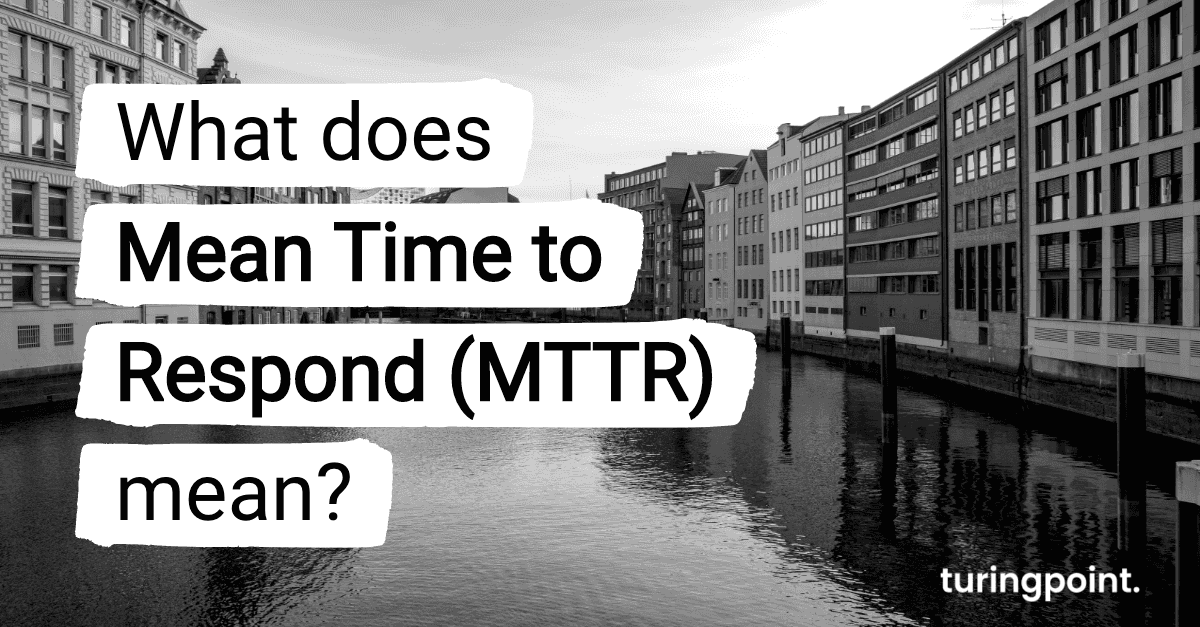What does Mean Time to Respond (MTTR) mean?
The MTTD describes the time required to detect an incident or security threat.

Table of content
Cyber attacks and data breaches pose an immense risk to businesses. This makes it all the more important to identify cyber threats as quickly as possible. After all, prompt response is the only way to avoid the catastrophic consequences. The foundation for this is a good understanding of IT security and excellent MTTR.
Mean Time to Respond and MTTD - The Differences
The Mean Time to Detect and the Mean Time to Respond are important performance indicators of internal cybersecurity.
- MTTD describes the time required to detect an incident or security threat.
- MTTR, by definition, refers to the time required to detect a threat. Or to control and resolve it.
Both performance values depend on different factors, especially the size and complexity of the network. At the same time, the level of expertise available determines how quickly organizations can respond.
Other Types of MTTR
In addition to Mean Time to Respond, there are other metrics that are critical to a secure IT environment. These include:
- Mean Time to Acknowledge: the MTTA begins at the time of discovery. It measures the average time it takes for the team to begin working on the problem.
- Mean Time to Failure: The metric refers to the mean duration between non-repairable system failures.
- Mean Time between Failures: Unlike MTTF, MTBF describes the time between repairable system failures. At the same time, it tests the reliability of a product.
Other meanings of the abbreviation MTTR
While the classic MTTR is an important performance indicator by definition, there are other types of MTTR.
Mean Time to Repair: The Mean Time to Repair defines the time required to repair a system. This includes the actual repair time and the test period.
Mean Time to Recovery: This factor describes the time required to recover from an incident. This metric is of particular importance for DevOps Security.
Mean Time to Resolve: This timeframe refers to all aspects surrounding the security incident. This includes the time it takes to identify, analyze and resolve the issue. At the same time, the metric refers to closing the security vulnerability so that it cannot occur again.
Here's How to Improve Mean Time to Respond
Company-specific measures are required to improve MTTR. They depend on the IT processes and procedures in place. There are some measures that will benefit the organization:
- Proper Incident Response Management helps reduce the time required. A detailed analysis of incidents also helps the company to reduce the number of incidents.
- Monitoring solutions make it possible to keep an eye on the continuous stream of real-time data. Potential problems can thus be identified earlier.
- An action plan supports the company in reacting correctly in the event of an emergency. This involves defining tailored responses for the incident in question.
- A Security Operations Center supports companies in automated incident management. This includes ensuring that the center immediately informs the relevant employees about the problems at hand.
- It is also useful to keep track of the Common Weakness Enumeration. This allows known vulnerabilities to be closed before system failure occurs.
This is Related to the Mean Time to Respond
MTTR describes the amount of time it takes for the DevOps team to recover the system after a failure. A good MTTR example is to measure the time period over 10 downtime incidents. Such values yield a reliable result that quantifies DevOps success. Ideally, the more mature the DevOps implementation, the lower the time required.
However, this metric does not only provide metrics in terms of time spent. It has a direct impact on a company's financial investment. The higher the productivity, the lower the costs. Of course, this is also true when downtime decreases. The metric is always a unit for analyzing the stability of the continuous development process.
What is Considered a Good Mean Time to Respond?
A good MTTR takes different factors into account. Regardless of the specific MTTR Example, five hours is a perfectly acceptable time frame. The following factors should be considered:
- Incident metrics: Metrics measurement ideally begins when the incident is identified. This point in time is rarely the same as ticket creation. By starting measurement immediately, more accurate results can be achieved.
- Avoid shortcuts: Organizations achieve better results when they avoid problem workarounds or shortcuts. To do this, it is necessary to follow the defined processes exactly, even if they extend the required timeframe.
- Additional measures: Continuous monitoring of the system reduces the number of system failures. This makes the rotational pentest as important as considering the OWASP Top 10.
Mean Time to Respond: Don't be Daunted By Complexity
The goal of MTTR is to help organizations with IT security. It is a mathematical equation that is relevant to all levels of business. It's natural that complexity increases as the size of the IT infrastructure increases. Nevertheless, this metric helps validate the effectiveness of incident management. This allows measures to be taken in the long term that actually move the company forward.
Contact
Curious? Convinced? Interested?
Schedule a no-obligation initial consultation with one of our sales representatives. Use the following link to select an appointment:
